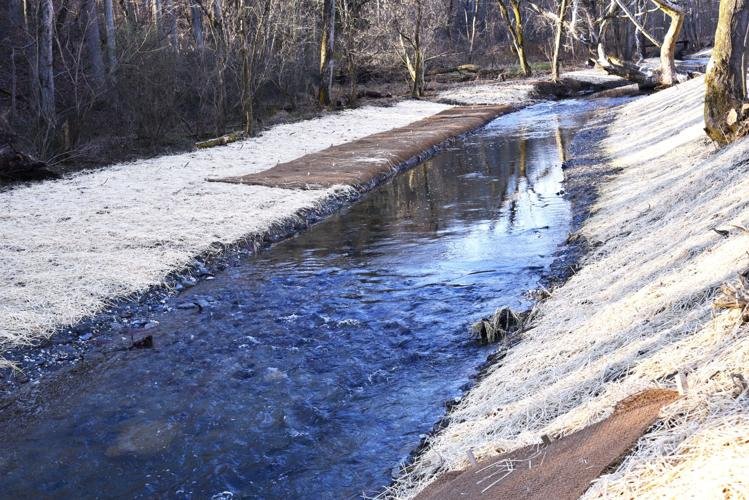Finishing touches under way in Lititz Run’s remarkable transformation
Source: Lancaster Online - AD CRABLE | Outdoors Columnist
12_24_23
No stream in Lancaster County has had as much restoration work performed on it than Lititz Run. No local stream, perhaps, has had a community pull so hard together to heal a waterway.
New riffles added to Lititz Run as it follows its natural course as part of restoration
work at the Millport Conservancy near Lititz.
For 33 years, the 6.5 miles of Lititz Run from its source from the spring in Lititz Springs Park, through the industrial heart of the borough, suburban neighborhoods and past farmland and on to its confluence with the Conestoga River has been slowly but surely doctored to be what it can be: a clean, healthy waterway that supports wild trout.
Though there is still work to be done, the persistence has already paid off in some amazing ways.
The Pennsylvania Fish and Boat Commission has changed Lititz Run’s classification from a warmwater stream to a coldwater stream, a remarkable turnaround.
After a study two years ago confirmed brown and brook trout were reproducing naturally, Lititz Run’s partners are now trying to get the commission to declare the stream a Class A Wild Trout Water which would accrue an extra layer of protection.
Few streams in Pennsylvania have undergone source to confluence restoration work as has Lititz Run.
The award-winning work continues even today at the nonprofit Millport Conservancy in Warwick Township where some of the first fledgling restoration work began in 1990 after the grassroots Donegal Chapter of Trout Unlimited showed up with shovels and crowbars to begin changing the stream for the better.
Some 1,200 feet of Lititz Run at the conservancy is now being narrowed, fitted with riffles and other fish habitat, and its banks flattened to sustain floodwaters without gouging the earthen banks and sending polluting soil downstream.
W. Logan Myers and Lynn Wohlsen Myers, co-conservators of the Millport Conservancy, stand beside stream restoration work being done on Lititz Run on conservancy property.
“It’s amazing how they are making it look. Absolutely gorgeous!” exclaimed Lynn Wohlsen Myers, executive director of the 85-acre conservancy, as she walked along a bank where heavy equipment was recontouring the stream and pushing into place large tree trunks that will both prevent erosion and give trout a place to lurk.
The project is the last section of Lititz Run to be restored at the conservancy. The $200,000 project, which began around Thanksgiving, is a partnership of the conservancy, U.S. Fish and Wildlife Service, Lancaster County Conservation District, Lititz Run Watershed Alliance and Warwick Township.
“This area is not easily accessible and had been a goal for over 25 years,” added her husband, W. Logan Myers, who serves as joint conservator with his wife of the conservancy and is its hands-on groundskeeper. “We’re getting the stream naturalized and to take its own course and moving sediment around,” he said.
The stream work also will enhance the conservancy’s mission of providing an outdoors classroom for education, from schoolchildren to local universities.
Earlier this year, the nonprofit North Museum of Nature and Science became a partner with the conservancy to expand STEM education programs as well as research opportunities for conservation and the environment.
The stream improvements will also better public recreation opportunities at the conservancy property at 737 E. Millport Road, Lititz. The conservancy has about 2 miles of trails and the stream work is creating a flat walkway between a small lake and the restored stream.
Logan Myers intends to put benches along the trail. “People will be able to stroll along this stream and pond within an arm’s reach on both sides,” he said. The conservancy is open to the public from dawn to dusk.
And the stream improvements will make Lititz Run even more enticing for catch-and-release fly fishers, both novice and accomplished. A $40 annual button is required to fish on the conservancy property. Money goes toward stocking the section. Buttons may be purchased at Precision Fly and Tackle in Lancaster as well as at Creekside Fly & Tackle, Leola.
When the Millport work is completed, another in-stream project has already been funded to improve another 1,600 feet from Lititz Run Road to W. Logan Myers Park.
Longterm, the Myers continue to work toward a dream of building a walkable greenway for the public along the entire length of Lititz Run. Part of that effort would include extending the current Warwick to Ephrata Rail Trail to Lititz Springs Park.
It’s estimated that between 80 and 95 percent of the entire length of Lititz Run and its tributaries has been addressed in some form.
A dam that blocked fish passage has been breached. Cows have been fenced from wading in the stream. Streamside buffers of grasses, shrubs and an estimated 8,000 to 12,000 trees have been planted by volunteers through the decades, shading the stream and filtering runoff. Sewage effluent has been better treated before reaching the stream. Wetlands have been created and floodplains improved to blunt flooding.
Even as Lititz Run turns cleaner bit by bit, it faces headwinds such as increasing development and the effects of climate change. “Stormwater runoff is a big problem” in developed areas, noted Matt Kofroth, former watershed specialist at the Lancaster County Conservation District.
Like most of the streams in Lancaster County, Lititz Run is still listed as an impaired waterway but is getting cleaner every day.
“It’s taken us over 20 years because, yes, it requires money to do the physical work, but there has to be a fundamental philosophical shift. Industries and farmers—you’re all stewards of the watershed. Everyone is a part of it. That’s taken a lot of time,” said Dan Zimmerman, former Warwick Township manager who helped shepherd the restoration work.
“Most things that are worthwhile do take a lot of time.”



